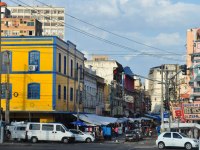The November 2010 trip to Brazil by the I2UD Board, and subsequent discussions with the Woods Hole Research Center in Falmouth, Massachusetts (WHRC), are opening a promising possibility for our involvement in the Amazon region.
After many years of economic turmoil, including a major debt crisis and a high inflation rate, verging on hyper-inflation in the early 1990s, Brazil has grown rapidly during a notable boom dating back to the year 2000. It has become the eighth largest economy in the world and its successful transition to democracy is now 26-years-old. The country is intent upon mobilizing its vast agricultural, petrochemical, industrial, and human resources for future development. Its National Bank for Economic and Social Development has total assets rivaling those of the World Bank. Brazil has also invested heavily in the creation of a good quality federal university system, albeit to the detriment of its notoriously weak primary and secondary schools.
Many outsiders perceive the Brazilian Amazon as under threat. Predatory development in the mining, agriculture, and timber industries has resulted in large-scale deforestation; negative environmental impacts on the river systems, flora, and fauna; and threats to the region’s traditional inhabitants. Brazil’s most rapid rates of urbanization now are occurring in the northern Amazonian region in a largely haphazard pattern resulting from people being pushed off of the land. Moreover, deforestation and inadequately planned development is contributing significantly to global warming.
Over the past months, a new strategic partnership has emerged between I2UD, the WHRC, and the newly inaugurated Federal University of Western Pará (UFOPA) located in the central Amazon city of Santarém, at the confluence of the Tapajós and Amazon rivers. For over two decades, WHRC scientists have conducted field research on the ecological systems of the central Amazon, modeling the impacts of deforestation on the region’s climate and hydrological systems.
The university has been charged with developing a new regional planning program with an emphasis on Amazonian issues. It has asked I2UD and WHRC to help it develop a curriculum that would combine planning and management strategies that maximize the economic and social benefits of development while minimizing their environmental and social impacts. The graduates of the program, with a multi-disciplinary education, will be in a unique position to positively influence Amazonian development through their university sponsored internships and subsequent professional careers in the region’s municipal and state governments.
The WHRC/I2UD/UFOPA proposal is to design and implement a program that will train the professionals who will be directly involved in the region’s planning. The combination of the experience and commitment of the UFOPA faculty in local government capacity building, WHRC’s scientific strengths, and the record of senior I2UD staff in university level teaching and managing spatial development promises to create a cutting edge program adapted to the unique needs of the Amazon region.
by Biorn Maybury-Lewis, Senior Associate
Building a New Planning Program in the Brazilian Amazon

